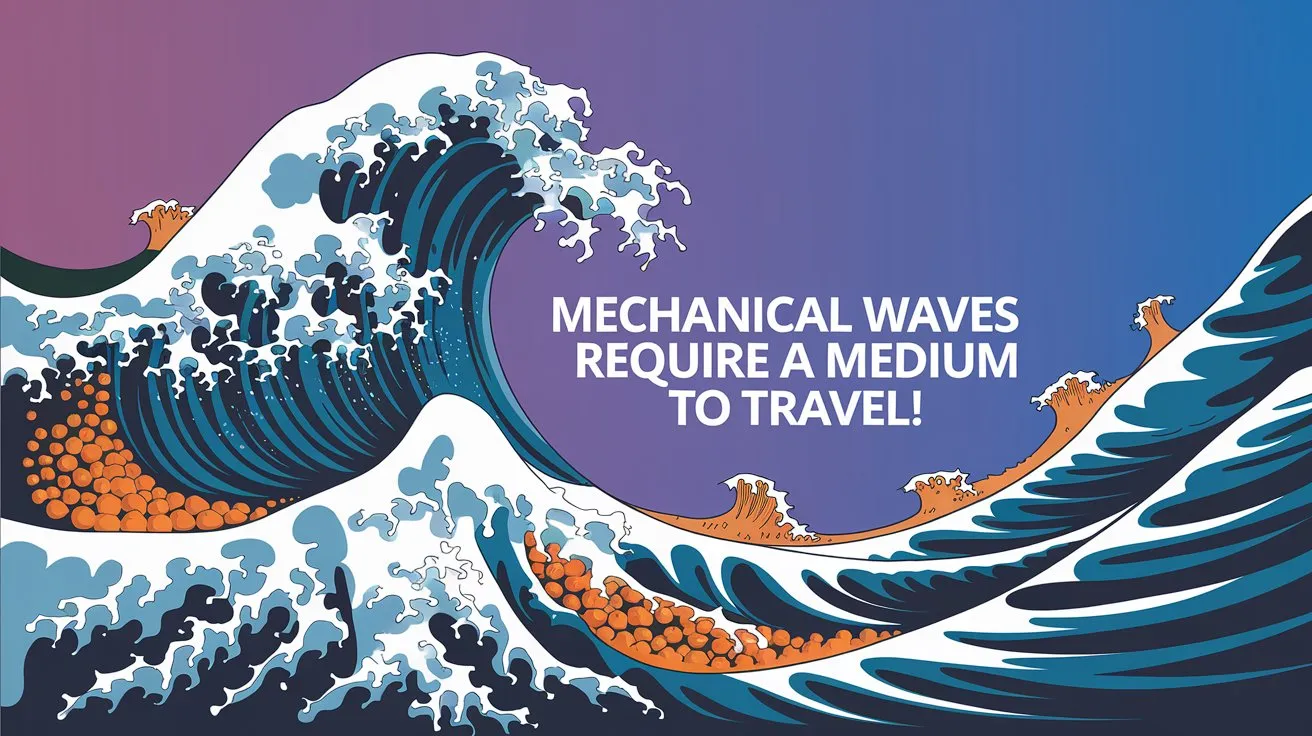Table of Contents
When we think about waves, we often imagine the ripples on a pond or the sound of a voice travelling through the air. But have you ever wondered, “Mechanical waves require what to travel?” Understanding the nature of mechanical waves and what they need to move can reveal fascinating truths about the world around us. This article will explore the essential elements that mechanical waves require to travel, breaking down complex ideas into simple, easy-to-understand concepts.
What Are Mechanical Waves?

Before we dive into what mechanical waves require to travel, let’s first understand what mechanical waves are. Mechanical waves are disturbances that move through a medium, transferring energy from one place to another. Unlike electromagnetic waves, which can travel through the vacuum of space, mechanical waves need a medium—such as solid, liquid, or gas—to move.
Types of Mechanical Waves
Mechanical waves come in two main types: transverse waves and longitudinal waves. Each type moves differently through a medium, but both require certain conditions to travel.
Transverse Waves
As transverse waves, the medium’s particles travel perpendicular to the wave’s direction. Imagine shaking a rope up and down; the wave travels along the rope while the particles move up and down. Exploring the essentials: Mechanical Waves Require What to Travel successfully? Light waves are a typical example of transverse waves, though they are not mechanical since they do not require a medium.
Longitudinal Waves
On the other hand, longitudinal waves move the particles of the medium in the same direction as the wave. A great example of this is a sound wave. When you speak, your vocal cords create vibrations in the air, pushing air molecules back and forth in the direction the sound travels. These back-and-forth motions create areas of compression and rarefaction, which we perceive as sound.
Mechanical Waves Require What to Travel? The Essential Medium
Now that we know what mechanical waves are let’s answer the critical question: What do mechanical waves require to travel? The answer is simple: a medium. Without a medium, mechanical waves cannot move. But what exactly is a medium, and why is it so important?
Understanding the Medium
A medium is any substance through which a mechanical wave can travel. This could be a solid, liquid, or gas. The medium provides the particles that transmit the wave’s energy from one place to another.
Solids, Liquids, and Gases as Mediums
Different types of media can affect how mechanical waves travel:
- Solids: In solids, particles are closely packed together, making it easier for waves to move quickly and efficiently. For example, sound waves travel faster through a metal rod than air.
- Liquids: In liquids, particles are more spread out than in solids, but they are still close enough to transmit waves effectively. Water waves, such as those seen in the ocean, are an example of mechanical waves moving through a liquid medium.
- Gases: In gases, particles are far apart, so waves travel more slowly. Sound waves in the air are a typical example of mechanical waves travelling through a gas.
How the Medium Affects Wave Speed and Behavior
The medium through which a mechanical wave travels allows the wave to move and influences its speed and behaviour. Understanding this can help answer the question, “Mechanical waves require what to travel?”
The Relationship Between Medium and Wave Speed
The speed of a mechanical wave depends on the properties of the medium, such as its density and elasticity. In general:
- Denser Media: Waves travel faster in denser media because the particles are closer together, making it easier to transfer energy.
- Elastic Media: The more elastic a medium, the faster the wave can travel. Elasticity is the ability of a substance to regain its previous shape after being disrupted. A stiffer medium, like steel, allows waves to move quickly.
Reflection, Refraction, and Absorption
When a mechanical wave encounters a boundary between two different media, it can be reflected, refracted, or absorbed, depending on the properties of the media.
- Reflection: If the wave hits a boundary it cannot pass through, it will bounce back, creating a reflected wave. This is what happens when you hear an echo in a canyon.
- Refraction: If the wave can pass into the new medium, it will change direction and speed, a process known as refraction. This is the reason why straw looks bent when it is placed in a glass.
- Absorption: Some of the wave’s energy may be absorbed by the medium, causing the wave to lose power and eventually dissipate. This is why sound becomes quieter as it travels farther from the source.
The Importance of Understanding Mechanical Waves
Understanding the question, “Mechanical waves require what to travel?” is more than just a scientific curiosity. It has practical applications in everyday life and various fields of study.
Applications in Engineering and Technology
Engineers use knowledge of mechanical waves to design buildings, bridges, and other structures that can withstand earthquakes, which are seismic waves travelling through the Earth. Understanding wave mechanics: Mechanical Waves Require What to Travel Efficiently? They also design communication systems that rely on sound waves, such as telephones and speakers.
Importance in Medicine
Mechanical waves are used in ultrasound imaging in medicine. Sound waves travel through the body, creating images of internal organs and structures. Understanding how these waves move through different tissues is crucial for accurate diagnosis and treatment.
Read Also: Dow Jones FintechZoom Today: Shocking Market Moves Revealed
The Hidden Truth of Mechanical Waves

Finally, the response to the question “What is required for mechanical waves to travel?” is a medium—a solid, liquid, or gas that allows these waves to move and transfer energy. Mechanical Waves Require What to Travel through various mediums like air or water? The medium determines wave transmission’s speed, behaviour, and effectiveness. From the ripples in a pond to the sound of your voice, mechanical waves are all around us, shaping our world in ways we often take for granted.
By understanding the hidden truths of how mechanical waves travel, we gain insight into the fundamental processes that govern our environment and the technology we use daily. So the next time you hear a sound or see a ripple, remember the fascinating journey of the mechanical waves that brought that energy to you.

